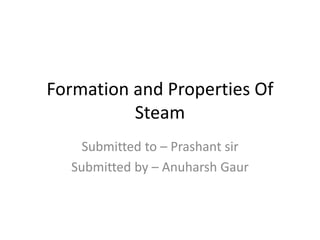
Formation and properties of steam
- 1. Formation and Properties Of Steam Submitted to – Prashant sir Submitted by – Anuharsh Gaur
- 2. Introduction: What is Steam? • Steam is vapour of water and is invisible when pure and dry • It is used as the working substance in the operation of steam engines and steam turbines • Steam does not obey laws of perfect gases until it is perfect dry
- 3. Formation of steam at a constant pressure from water
- 5. Theoretical description of above figure • Consider 1 kg of water at 0 degree Celsius contained in piston cylinder arrangement as shown in above figure(i) the piston and weights maintains a constant pressure in cylinder *if we heat water contained in cylinder it will converted to steam as follows
- 6. Contd….. • The volume of water will increase slightly as increase in temperature hence it will cause the piston to move upwards and work is obtained . • On further heating temperature reaches boiling point , the boiling point of water is 100 degree Celsius at 1.103 bar but increases with increase in pressure . When boiling point is reached, temperature remains constant and water evaporates thus pushing the piston up at constant pressure . The specific volume of steam increases as shown in (iii). At this stage steam will have some particles of water in suspension and is termed as wet steam . Process will continue till whole water is converted to steam
- 7. Cont.. • On further heating the suspended water particles will get converted into steam. The entire steam in such a state is called dry steam (iv). It acts as a perfect gas • On further heating the temperature of steam starts rising and is termed as superheated steam(v)
- 8. Temperature vs Total Heat Graph during Steam Formation
- 9. Theoretical explanation of above graph • The process of steam formation above can also be explained in graphical form. • The point A represents the initial condition of water at 0 degree Celsius and pressure ‘p’. • The graph is depicted in following three stages
- 10. Cont.. 1. The heating of water up to boiling temperature or saturation temperature ‘Ts’is shown by AB the heat absorbed by water is AF known as sensible heat 2. The change of state from liquid to steam is shown by BC heat absorbed during this stage is FG known as latent heat of vaporization 3. The superheating process is shown by CD heat absorbed during stage is GH , known as heat of superheat
- 11. Cont.. • If the pressure is increased the boiling temperature also increase. The point B1 represent the boiling temperature or saturation temperature at pressure p1 and point F is point of dry saturated steam • Line C1D1 shows the constant pressure process in which steam is super heated
- 12. Cont.. • Line passing through points A,B,B1,B2 are known as saturated liquid line • Line passing through A1,C,C1,C2 are known as dry saturated steam line .
- 13. Important terms for steam
- 14. Basic definitions • Wet steam – when the steam contains the moisture or particles of water in suspension . it is said to be wet steam ,evaporation of water is not complete and whole of latent heat is not absorbed • Dry saturated steam when the wet steam is further heated and it does not contain any suspended water particles it is called dry steam
- 15. Cont.. • Superheated steam- when dry steam is further heated at constant pressure thus raising its temperature i.e. it is said to be super heated steam • Sensible heat – it is the amount of heat absorbed by 1 kg of water to raise the temperature from 0 degree to temperature of saturation point
- 16. cont • Latent heat of vaporization- it is the amount of heat required to evaporate 1 kg of water at its boiling point without changing its temperature • Specific volume – it is defined as volume occupied per unit mass at a given temperature and pressure.
- 17. Advantages of Superheated Steam • We already know that when dry steam is further heated then the steam is superheated steam . The process of superheating follows Charles law 1 . It contain more heat content and has more power to do a specific work 2. Increased thermal efficiency
- 18. Internal energy of the system • It is the actual heat energy stored in the system above the freezing point of water • It is calculated by subtracting external work done during evaporation from enthalpy or total heat of steam .
- 19. Dryness Fraction • It is defined as ratio of mass of actual dry steam to the mass of same quantity of wet steam • Generally denoted by ‘x’ • Formulae – Mg/Mg+Mf = Mg/M Mg = mass of dry steam Mf = mass of suspended water particles M = Mg+Mf
- 20. References • Slideshare.net • Google.com • Wikipedia.org
- 21. Thank you